Lieutenant Colonel Alexander Windeyer Ralston
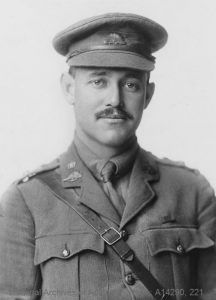
Alexander Windeyer Ralston. Courtesy National Archives of Australia
When World War I broke out in August 1914, a number of Strathfield locals quickly answered the call to arms. Among the first to volunteer was Alexander Windeyer Ralston, a barrister, who enlisted with the Australian Naval and Military Expeditionary Force (AN&MEF) on 14 August 1914. His diary for 1914 is now in the collection of the Australian War Memorial. Ralston was the eldest son of Judge Alexander Gerard Ralston of Strathfield and his wife, Mary. At various times Judge Ralston served as an alderman on Ashfield, Burwood and Sydney City Councils.
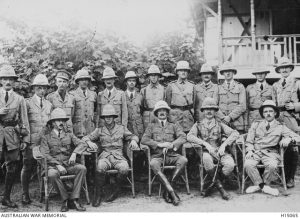
Outdoor group portrait of officers of the Rabaul Garrison of the Australian Naval and Military Expeditionary Force, 1914. Alexander Ralston is seated second from left. Courtesy Australian War Memorial.
After serving at Rabaul, New Guinea, Ralston returned home in January 1915 but soon re-enlisted with the Australian Imperial Force (AIF). In May 1915 he was appointed major with the 19th Battalion, which had been raised at Liverpool during March, and went on to serve at Gallipoli until the evacuation in December. On the peninsula, the 19th Battalion took part in the second attack on Hill 60 in late August and was also responsible for the defence of Pope’s Hill.
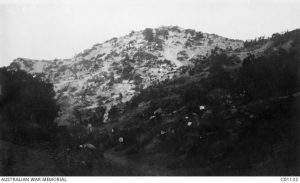
Dugouts on the slopes of Pope’s Hill on the Gallipoli Peninsula. The hill was named after Colonel Harold Pope, commanding officer of the 16th Battalion, who reached it late on 25 April 1915. Courtesy Australian War Memorial.
In June 1916 he was appointed lieutenant colonel with the 20th Battalion. Aged only 30 at the time, he was thought to have been one of the youngest colonels serving with the Allied forces. In March 1918 he was appointed to command the 2nd Machine Gun Battalion.
Alexander Ralston was highly decorated, earning the Distinguished Service Order for his actions near Pozières on the Western Front in August 1916:
‘He showed great skill in the handling of his Bn. During the successful attack on the enemy’s position south of Bapaume Road on the night of 4th/5th August. He was fearless in action, a good administrator, and untiring in his attention to the welfare of his unit at all times.’
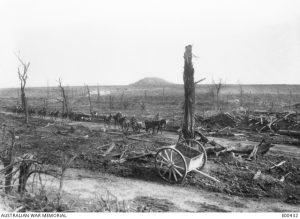
Australian transport returning along the Bapaume Road for supplies, March 1917. In the background are Le Sars Railway Station, the Quarry, and the Butte de Warlencourt (centre). Courtesy Australian War Memorial.
In 1917, Ralston was awarded the Companion of the Order of St Michael and St George for his ‘most excellent’ work in France ‘on April 15th when he was ordered to counter-attack, recapture Lagnicourt and restore the line. The battalion was handled so brilliantly that all tasks were successfully carried out.’
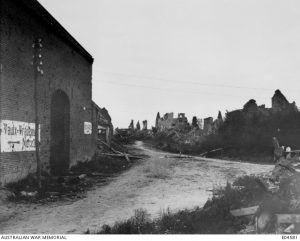
The remains of Lagnicourt, 16 September 1917. Courtesy Australian War Memorial.
He was also mentioned in despatches on several occasions.
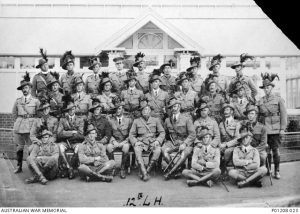
Group portrait of officers of the 12th Light Horse Regiment. Lt. Edward Bolton is on the left in the front row. Courtesy Australian War Memorial.
His younger brother, Edward Bolton Ralston also served during World War I, as a lieutenant with the 1st and 12th Light Horse Regiments. In Egypt in 1916 he suffered from malaria and dengue fever and was sent home for recuperation, embarking again in March 1917. He was badly wounded in the arm during the charge of the Light Horse Brigade at Beersheba on 31 October 1917 and was invalided home to Australia again during 1918. He also served with the Camel Corps. After the war he settled on the Central Coast and died in 1967.
Alexander Windeyer Ralston married in 1927 and settled in the Eastern Suburbs. He died in 1971.
by J.J. MacRitchie
Local Studies Advisor
References
https://www.awm.gov.au/collection/C89475
https://www.sydneyaldermen.com.au/alderman/alexander-ralston/
https://www.awm.gov.au/collection/U51459
https://s3-ap-southeast-2.amazonaws.com/awm-media/collection/RCDIG1068635/document/5511300.PDF
https://s3-ap-southeast-2.amazonaws.com/awm-media/collection/RCDIG1067920/document/5485582.PDF

2 Comments. Leave new
I look forward to the Thursday Council news. Wonderful articles on our history, very informative.
As a child my Doctor, Arnold Evans had served in Gallpoli. His home and surgery was on the corner of Homebush Rd and Albert Rd. I believe it was built as a wedding present.
Thank you Julianne. Dr Arnold Stratfull Evans served as a Second Lieutenant with the 20th Battalion at Gallipoli and was wounded in 1916 at Pozieres. He was from Narrandera, NSW and settled in Homebush after the war. He died in 1972.